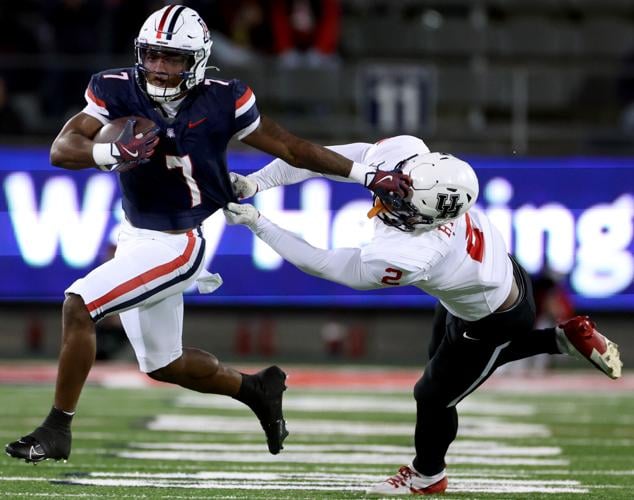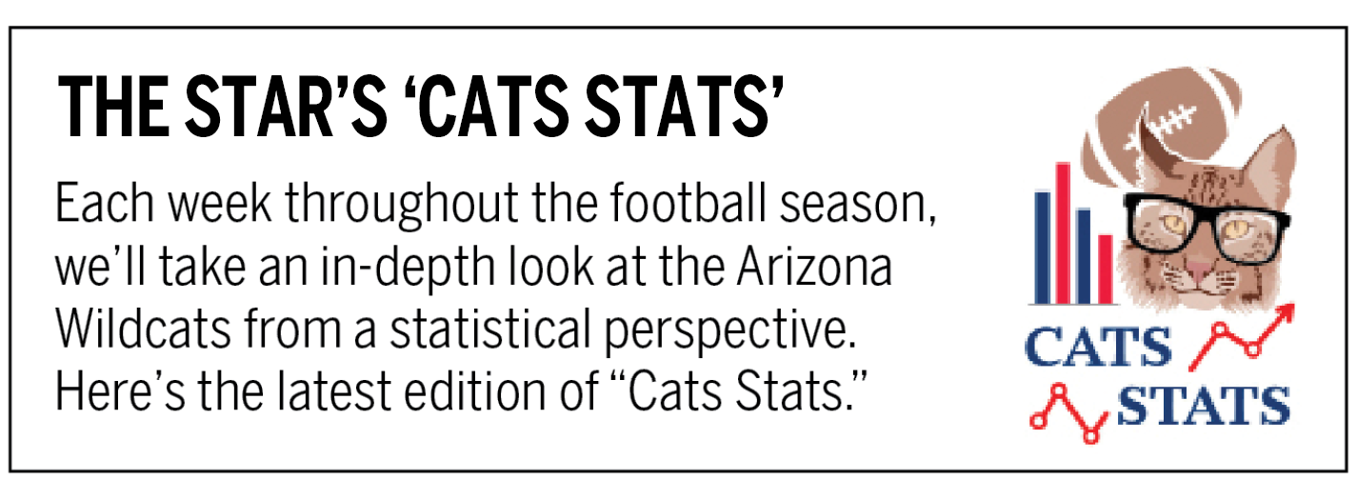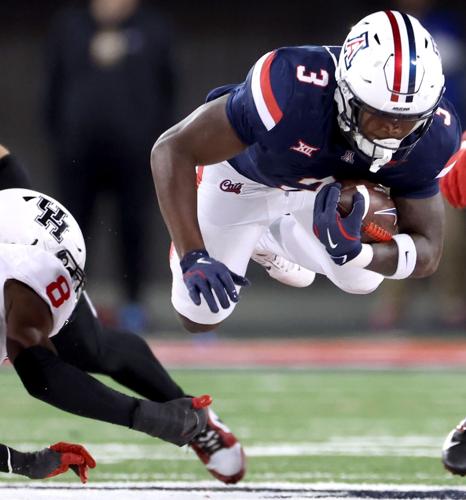Did Arizona’s previously punchless rushing attack experience a breakthrough in the second half against Houston last week?
The Wildcats certainly hope so. Because if they’re to have any shot to upset TCU on Saturday, they’ll need to replicate their performance from the final 30 minutes against the Cougars.

Arizona rushed for 107 yards after halftime. That equaled the Wildcats’ total vs. Colorado on Oct. 19 and exceeded their combined output from the previous two games (83 yards vs. West Virginia and UCF).
Arizona’s overall total of 122 rushing yards also reversed a downward trend — fewer rushing yards each week after a 161-yard performance at Utah on Sept. 28.
“I thought that was great,” UA coach Brent Brennan said. “The bye week (gave) us some time to dive into some fundamental football. And that (is) such a part of the run game — blocking, stepping with the right foot, going to the right guy ... pad level.”
People are also reading…
Arizona still ranks 13th in the 16-team Big 12 Conference at 115.7 rushing yards per game — “I think we all agree that it hasn't been consistent or efficient enough,” Brennan said — and there are multiple reasons for that.

Arizona running back Jacory Croskey-Merritt checks for pursuit as he leaves everybody in his wake on the way to the end zone against New Mexico in the fourth quarter on Aug. 31, 2024, at Arizona Stadium. It would be the only game Croskey-Merritt would play for the Wildcats.
We’ll examine all aspects of the Wildcats’ run game in this week’s “Cats Stats.”
Personnel changes
Any discussion of Arizona’s ground game has to begin with the players who are no longer a part of it.
Jonah Coleman, DJ Williams and Michael Wiley accounted for 1,554 of the Wildcats’ 1,816 rushing yards last season, or 85.6%. Coleman transferred to Washington; Williams and Wiley ran out of eligibility.
Arizona assembled a new tailback corps featuring transfers Jacory Croskey-Merritt, Quali Conley and Kedrick Reescano.
Croskey-Merritt rushed for 1,190 yards and 17 touchdowns last season at New Mexico. But his season ended after just one game because of an eligibility issue that never was resolved. He was trending toward becoming the Wildcats’ lead back, rushing for 106 yards and a touchdown on just 13 carries vs. UNM in the season opener.
With holdover Rayshon Luke electing to redshirt after making four appearances, Arizona essentially became a two-back attack led by Conley and Reescano. Conley, a senior, followed the staff here from San Jose State, where he rushed for 842 yards last season. Reescano, a sophomore, played exclusively on special teams as a freshman at Ole Miss.
“A lot of people want to try to figure out who we don't have, who's missing, all the different moving parts,” UA running backs coach Alonzo Carter said. “We don't flinch. They're a tight group of guys.
“You got a guy like Quali that, if you've been at practice, you'll see that two or three of those days, he's very limited, and he comes out there and gives you 100%. You got a guy like Kedrick, the young guy, (who) has had to step it up and play more than anticipated. We knew the upside was there, the potential was there, but we didn't know when that opportunity was going to come.”

Arizona running back Quali Conley (7) heads into the end zone on a 50-yard run, a one-play drive for the Wildcats, in the third quarter against Houston on Nov. 15, 2024, at Arizona Stadium.
Production so far
Conley ranks 11th in the Big 12 — which is loaded with quality running backs — with 677 yards. His average per carry of 5.3 yards ranks 14th among qualifiers.
Conley has gained a lot of those yards on his own, underscoring Arizona’s offensive line struggles. He ranks fifth in the Big 12 with an average of 4.02 yards after contact per rushing attempt, according to Pro Football Focus (minimum 51 carries). The latter exceeds what Wiley (3.44) and Williams (2.87) were able to do last season — but is well shy of Coleman’s mark of 5.09, which was the best in the Pac-12 by a full yard.
Reescano is averaging 3.48 yards after contact per attempt, which ranks 15th in the Big 12. He has forced 20 missed tackles in just 63 total carries, per PFF. On a per-carry basis, Reescano is comparable (31.7%) to the league’s best tackle breakers such as ASU’s Cam Skattebo (33.1%) and UCF’s RJ Harvey (30.8%). Conley has forced a missed tackle on 22.8% of his rushes (29 of 127).

Houston defensive back Kentrell Webb, left, sends Arizona running back Kedrick Reescano flying on a hit near the line of scrimmage in the fourth quarter of their Big 12 game, Nov. 15, 2024, at Arizona Stadium.
Overall, Arizona’s rushing production isn’t as far off last year’s output as you might think. The raw numbers show a drop of 24 yards per game and .51 per carry. If you take out sacks — which count toward teams’ net rushing totals in college football — those gaps shrink to 18.6 yards per game and .22 per carry.
Commitment issues
After adjusting for sacks, Arizona is averaging just 2.4 fewer carries per game than a year ago. That’s a surprisingly small difference considering how often the 2024 Wildcats have been playing from behind compared to last year’s squad.
The 2023 Cats had 208 carries with the lead, or 16 per game, according to CFBStats.com. The ’24 club has 97 carries with the lead, or 9.7 per game.
The difference in carries with a deficit of 15-plus points illustrates the divergent paths these past two UA teams have taken. Last year’s squad had just four carries with a deficit that large; this year’s has 67.
The Houston game presented a rare opportunity to play with a multiple-score lead. Conley’s 13-yard touchdown reception less than five minutes into the second half put Arizona ahead 17-3. The Wildcats had 21 rushing attempts after halftime — compared to 16 passing attempts. Arizona finished with 36 rushing attempts (a season high) and 35 passing attempts, marking just the third time this year the Wildcats have had more of the former.

Arizona running back Quali Conley, left, stiff-arms his way around Houston defensive back A.J. Haulcy (2) in the third quarter of their Big 12 game on Nov. 15, 2024, at Arizona Stadium.
San Jose State never ranked in the top half of the Mountain West Conference in rushing attempts during Brennan’s seven seasons there. The Spartans’ highest ranking in that category was seventh (2020), and they finished last or next-to-last four times. Arizona has a different offensive coordinator, but those numbers at least hint at Brennan’s overall offensive philosophy.
TCU’s vulnerability
If the Horned Frogs are susceptible anywhere on defense it’s in the run game.
TCU ranks 14th in the Big 12 in rushing defense (172.1 yards per game) compared to third in passing defense (186.5). If you exclude sacks, the Horned Frogs yield 188.8 rushing yards per game and 4.96 per carry.
Six teams have rushed for at least 167 yards against TCU, and four have topped 200: UCF, SMU, Houston and Baylor. The Horned Frogs are 2-4 when allowing 167 or more rushing yards.
TCU has the most prolific passing offense in the Big 12 and would like nothing more than to turn this game into a Texas shootout. Arizona’s chances of competing will improve substantially if the Wildcats can control the ball by running it like they did in the second half vs. Houston.
Contact sports reporter/columnist Michael Lev at mlev@tucson.com. On X(Twitter): @michaeljlev
















